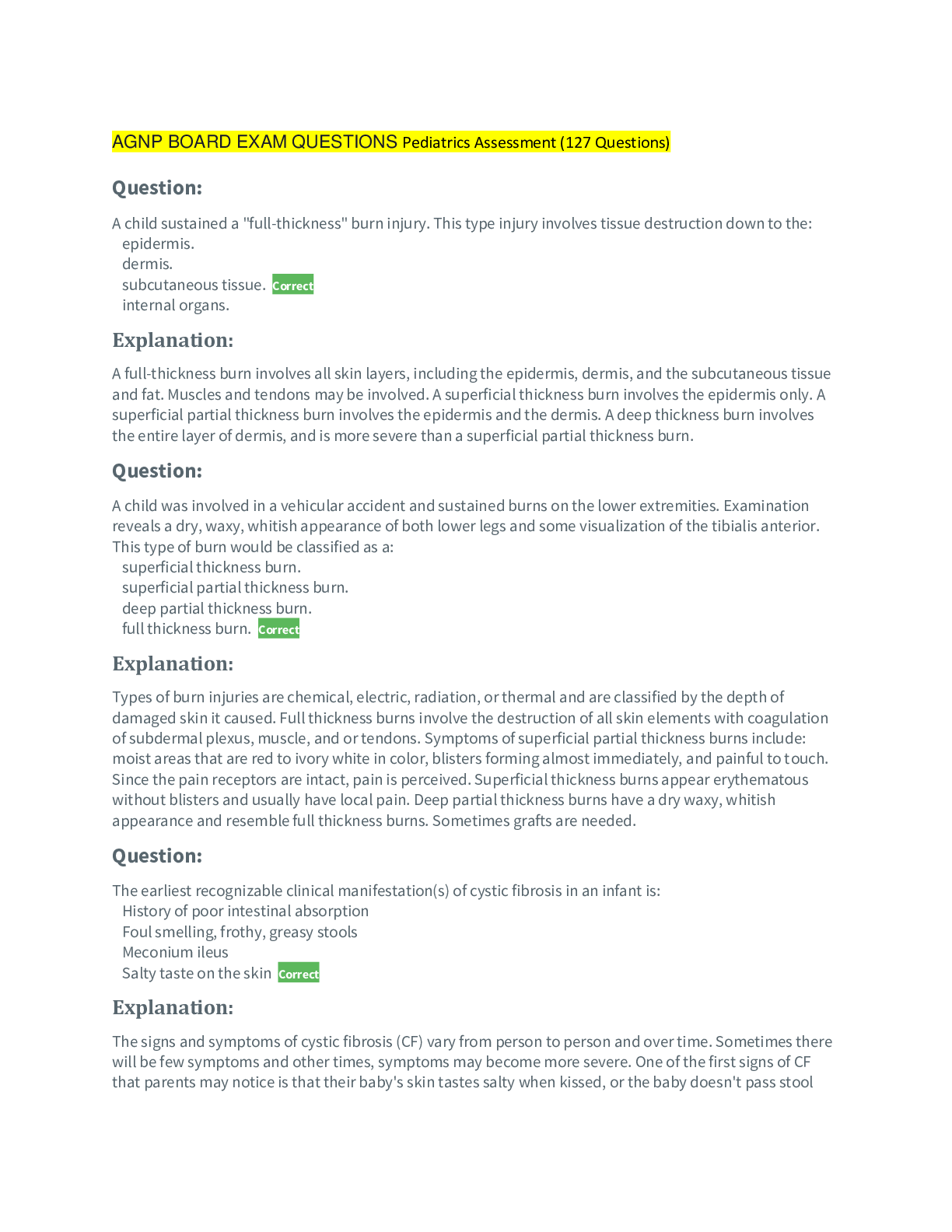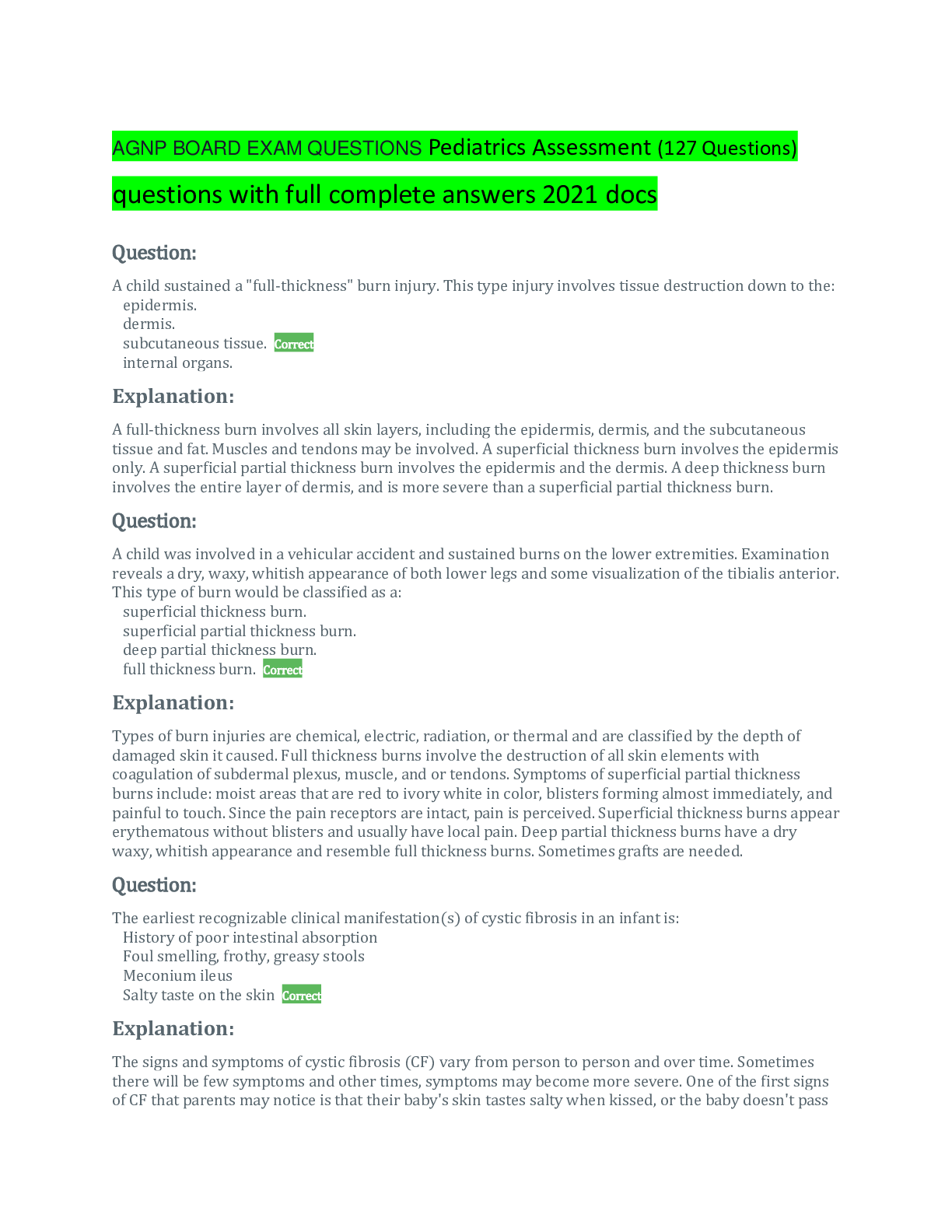AGNP BOARD EXAM QUESTIONS Pediatrics Assessment (127 Questions and Answers)
Document Content and Description Below
AGNP BOARD EXAM QUESTIONS Pediatrics Assessment (127 Questions and Answers) Question: A child sustained a "full-thickness" burn injury. This type injury involves tissue destruction down to the: ... epidermis. dermis. subcutaneous tissue. Correct internal organs. Explanation: A full-thickness burn involves all skin layers, including the epidermis, dermis, and the subcutaneous tissue and fat. Muscles and tendons may be involved. A superficial thickness burn involves the epidermis only. A superficial partial thickness burn involves the epidermis and the dermis. A deep thickness burn involves the entire layer of dermis, and is more severe than a superficial partial thickness burn. Question: A child was involved in a vehicular accident and sustained burns on the lower extremities. Examination reveals a dry, waxy, whitish appearance of both lower legs and some visualization of the tibialis anterior. This type of burn would be classified as a: superficial thickness burn. superficial partial thickness burn. deep partial thickness burn. full thickness burn. Correct Explanation: Types of burn injuries are chemical, electric, radiation, or thermal and are classified by the depth of damaged skin it caused. Full thickness burns involve the destruction of all skin elements with coagulation of subdermal plexus, muscle, and or tendons. Symptoms of superficial partial thickness burns include: moist areas that are red to ivory white in color, blisters forming almost immediately, and painful to touch. Since the pain receptors are intact, pain is perceived. Superficial thickness burns appear erythematous without blisters and usually have local pain. Deep partial thickness burns have a dry waxy, whitish appearance and resemble full thickness burns. Sometimes grafts are needed. Question: The earliest recognizable clinical manifestation(s) of cystic fibrosis in an infant is: History of poor intestinal absorption Foul smelling, frothy, greasy stools Meconium ileus Salty taste on the skin Correct Explanation: The signs and symptoms of cystic fibrosis (CF) vary from person to person and over time. Sometimes there will be few symptoms and other times, symptoms may become more severe. One of the first signs of CF that parents may notice is that their baby's skin tastes salty when kissed, or the baby doesn't pass stool when first born. Most of the other signs and symptoms of CF happen later. They're related to how CF affects the respiratory, digestive, or reproductive systems of the body. Question: An infant presents with a rash in the diaper area. Which description likely indicates candidal diaper rash? Red, moist, maculopapular patch with poorly defined borders in diaper area Bright red, moist patches with sharply demarcated borders, some loose scales noted in the diaper area Correct Moist, thin-roofed vesicles with a thin, erythematous base noted in the diaper area Erythematous and symmetric rash noted in the diaper area Explanation: Candidiasis is characteristic of a rash appearing with bright red, moist patches with sharply demarcated borders, with some loose scales noted in the diaper area. Red, moist, maculopapular patch with poorly defined borders in diaper area is diaper dermatitis. Moist, thin-roofed vesicles with a thin, erythematous base noted in the diaper area would be consistent with impetigo. Hives appear as erythematous and symmetric and can be generalized over the body including the diaper area. Question: Examination of a child who experienced a burn from a curling iron on the forearm appears red without blistering but is painful to touch. This type of burn would be classified as a: superficial thickness burn. Correct superficial partial thickness burn. deep partial thickness burn. full thickness burn. Explanation: Types of burn injuries are chemical, electric, radiation, or thermal and are classified by the depth of damaged skin. Superficial thickness burns appear erythematous without blisters and usually have local pain. Symptoms of superficial partial thickness burns include: moist areas that are red to ivory white in color, blisters forming almost immediately, and painful to touch. Since the pain receptors are intact, pain is perceived. Deep partial thickness burns have a dry waxy, whitish appearance and resemble full thickness burns. Sometimes grafts are needed. Full thickness burns involve the destruction of all skin elements with coagulation of subdermal plexus, muscle, and or tendons. Question: A small child sustained burns to the posterior trunk and posterior surface of both arms. According to the "Rule of Nines" for small children, what percentage of the total body surface area was involved? 9%. 18%. 27%. Correct 32.5%. Explanation: The "Rule of Nines" assigns percentage of body surface area burned based on the location of the burn. The percentages are as follows: head and neck = 18%, anterior and posterior chest = 18% each, arms (anterior and posterior) = 4.5% each, legs (anterior and posterior) = 6.7% each, and perineum = 1%. For this example, 18% for posterior trunk plus 9% for arms = 27%. Question: If a newborn is suspected of having congenital hypothyroidism, which clinical manifestation would be evident? Prematurity Hyperthermia Hyperactivity Enlarged anterior fontanel Correct Explanation: Infants with congenital hypothyroidism are usually born at term or after term. Most practitioners now depend on the screening test in newborns to diagnose this condition since the symptoms or signs take time to develop. The symptoms of congenital hypothyroidism may include some of the following: puffy face, coarse facial features, enlarged anterior fontanel, thick protruding tongue, poor feeding, constipation or reduced stooling, prolonged jaundice, decreased activity with hypotonia, hypothermia and cool and pale skin, goiter, birth defects (e.g., heart valve abnormality), poor weight gain due to poor appetite, and swollen hands, feet and genitals. Question: A child has a maculopapular, blotchy rash and on examination of his mouth, red eruptions with white centers on the buccal mucosa are visualized. These eruptions are called: rubella spots. aphthous ulcers. Pastia's spots. Koplik spots. Correct Explanation: Koplik spots are seen with measles. They are small, white spots (often on a reddened background) that occur on the inside of the cheeks early in the course of red measles, rubeola. Pastia's spots are pink or red lines that are formed of confluent petechiae found in skin creases and are seen in patients who have scarlet fever. Aphthous ulcers are recurrent small, round, or ovoid ulcers with circumscribed margins, erythematous haloes, and yellow or gray floors occurring in the mouth. Question: When suspecting pediculosis capitis, the chief complaint is: itching. Correct hives. alopecia. vesicles. Explanation: With pediculosis capitis (lice), itching is the most common symptom and is caused by an allergic reaction. Lice will bite the skin in order to feed on the infected person's blood. Saliva from these bites causes the allergic reaction and itching. The lice lay eggs that eventually hatch which causes more irritation. Vesicles, fluid filled lesions, are not usually seen in this condition. Alopecia may be seen with tinea capitis. .............Continued [Show More]
Last updated: 2 years ago
Preview 1 out of 41 pages

Buy this document to get the full access instantly
Instant Download Access after purchase
Buy NowInstant download
We Accept:

Also available in bundle (1)

AGNP BOARD EXAMS (23 Different Versions) ; Questions and Answers
AGNP BOARD EXAMS (23 Different Versions) ; Questions and Answers
By YourTutor 4 years ago
$95.5
23
Reviews( 0 )
$25.50
Can't find what you want? Try our AI powered Search
Document information
Connected school, study & course
About the document
Uploaded On
Feb 01, 2021
Number of pages
41
Written in
Additional information
This document has been written for:
Uploaded
Feb 01, 2021
Downloads
0
Views
106













 Pediatrics Assessment (127 Questions) – South University Savannah.png)



 - South University.png)

